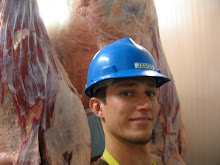Lima Peru, February 15, 2010
Buenos Dias Lima!
We woke early and had a quick breakfast in the hotel. We boarded the bus at 7:00 AM and went directly to SENASA- the national security for public health and agriculture (loosely translated).
We had a presentation about agriculture in Peru from a representative from the USDA. Gene Philhauer is the FAS director for Peru, Ecuador and Bolivia. He discussed the Peru free trade agreement with the United States. We also learned about exports from the United States also now have zero tariffs. The main exports for Peru include soybeans, corn, wheat, sorghum and some beef. Other specialty products include beer and wine. He felt that there was potential in more exports for wine to Peru, although there is much competition from Chile and Argentina. Currently all wine exports go to the restaurants.
Some of the largest challenges Peru faces in its agricultural infrastructure largely are based on transportation, lack of research and disregard for the laws. There are laws in place, but the government does not enforce them. He is also hoping to obtain a Spanish speaking extension service position to share information to subsistence farmers in the highlands. He also discussed the main areas of large-scale agriculture operations, located in the coastal desert areas, and also discussed the highlands and its subsistence farmers.
Next we had a discussion on the political climate of Peru from the political advisor to the US Embassy. He talked about the lack of confidence in elected officials. As of this morning’s paper, there was 81% of the general public who felt like they are not represented by their government. Many in our class felt the same way. They also had over twenty presidential candidates. Another interesting aspect in Peru is that elections are mandatory for adult citizens. As they vote, they obtain a stamp. The stamp is essential for registering your car, obtaining loans or participating in government programs in the future.
We then had two speakers from environmental NGO’s. They discussed the issues with Peru and its biodiversity. They also explained how land ownership works and property rights. The take home message here is that there may be environmental laws on the books but nobody is there to enforce it.
Our class then went to the International Potato Research Institute. We had a talk regarding all of the different potato varieties- over 4,000 domesticated varieties are found in Peru yet only 50 varieties can be found in stores. They have sent 50,000 germplasm samples to 153 countries world-wide from that facility. They conducted outreach with local Peruvian subsistence farmers and helped them add value to their products and assisted them in obtaining organic certification. This has been vital in marketing their crops and maximizing profitability.
Our class ate lunch consisting of chicken and french fries (some compare it to Woolgrowers at Los Banos). We had some Chichamorada (purple corn soda). A select few of us after lunch went to the supermarket to pick up supplies to make sandwiches for the next day.
We then started south on the Pan-American Highway. We were soon out of the affluent areas in Lima and into the hard reality of most Peruvians- poverty. The many dwellings were primarily shanty homes and shacks. The area was devoid of any vegetation- we were officially in the arid desert of Peru, overlooking the Pacific Ocean.
We saw many different examples of agriculture along the drive, processing tomatoes, chicken houses, grapes, asparagus, yucca, banana, peppers and cotton.
After the long trek through the desert, we finally arrived at Tacama Winery at sunset. Nearing the winery, our bus was nailed by water balloons by a few kids perched in a tree. We had a tour of the winery and had a presentation of Peruvian prancing horses. We had some Pisco and were soon on our way- late for dinner at Juanita’s Pot.
We finally met Claus (I've been emailing him for months now...), the main contact for the housing project. We had a presentation on the project and enjoyed some very authentic Peruvian food (again!). We learned about the future plans of Huamani and that our fundraising accounted for materials for 30 homes! We thought that we were only going to get enough funding for two homes, but the mesh we purchased was enough for 30!!!!!! We then went to the hotel, took a quick dip in the pool and went promptly to bed, in anticipation of being up very early the next morning.




Very interesting. Imagine how politics would change in the United States if everyone was required to vote. Obama might might have a chance at a second term!
ReplyDeleteCan you bring back some heirloom Peruvian potatoes! That would be a hit at the Ferry Plaza market!